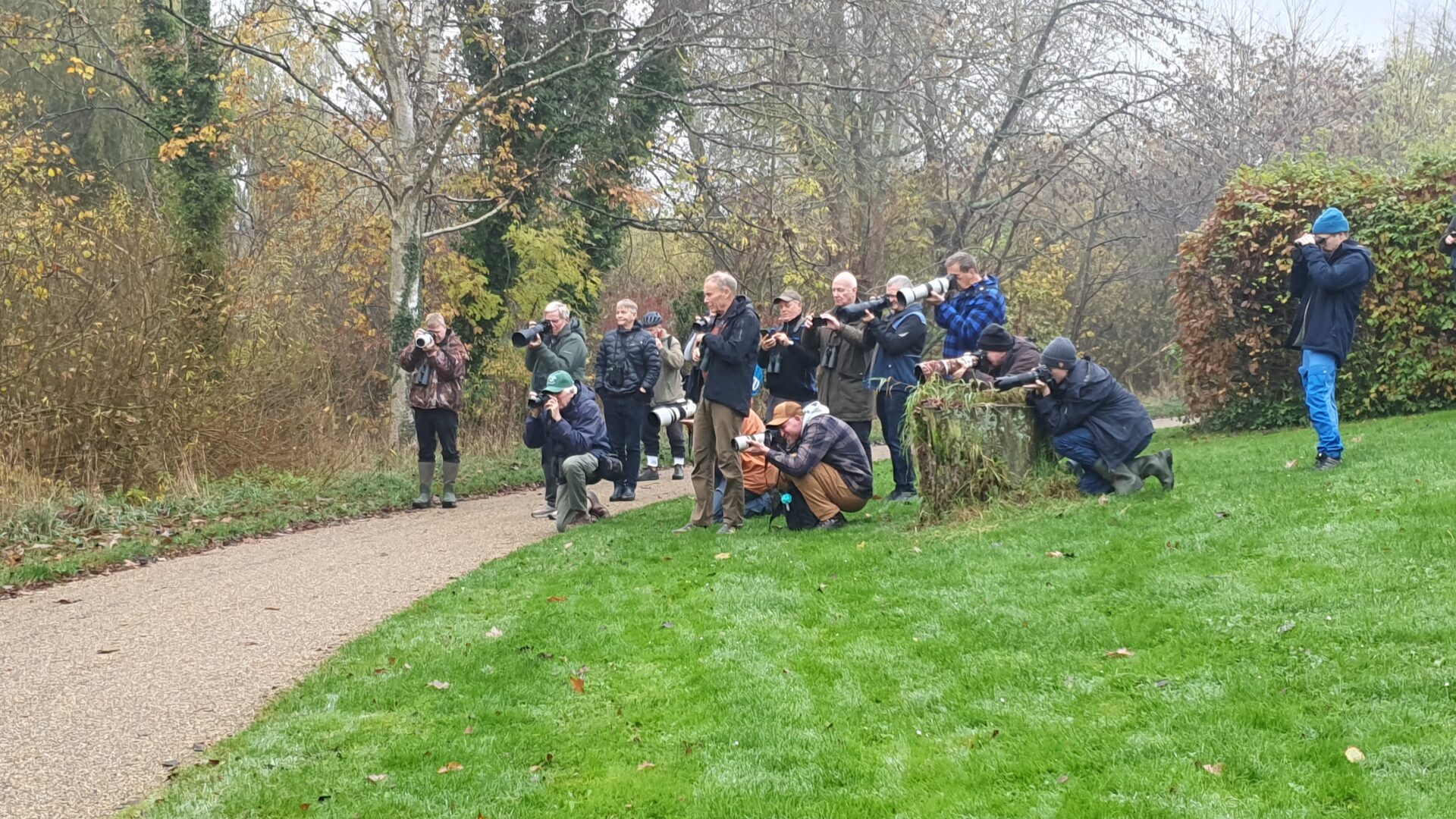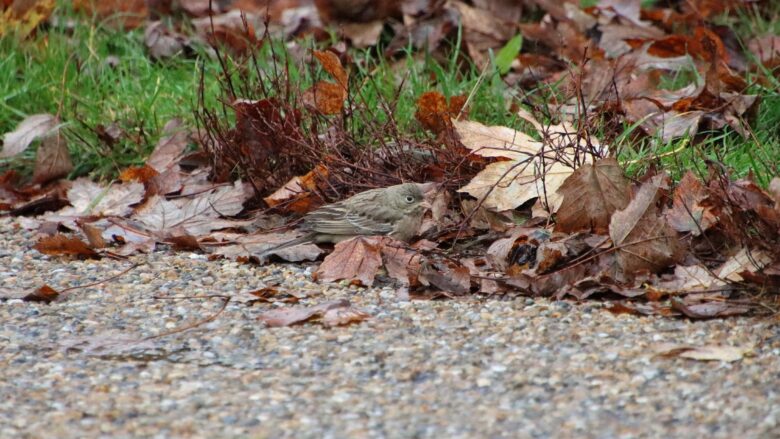This post is also available in: Dansk
A NFL at the Cowboy City: Grey-necked Bunting
On October 28, 2024, a Grey-necked Bunting (Emberiza buchanani) was found in North Zealand – specifically in Sortemosen, Hareskovby. It was actually an NFL and that’s pretty wild! NFL is birder-lingo for a new species for the country. A bird species that has never before been recorded in Denmark, so it has nothing to do with North American football. The bird was feeding along the path system at the Cowboy City (Cowboybyen) housing association and was very trusting. Although the species has been long awaited in Denmark, it was still a surprise. If nothing else, the location was very much a surprise. The Grey-necked Bunting is a Central Asian species that lives on dry, rocky mountainsides, in ravines and on grassy highland plateaus. The species overwinters in India. And now one individual was sitting on a pedestrian and bicycle path in a residential neighborhood just outside Copenhagen!
We were on the island Møn when the bird was reported on BirdAlarm. Had we been in Copenhagen, we would have moved on the bird immediately. But even if we threw our stuff in the car, we probably wouldn’t have arrived in Hareskovby until darkness fell. And there was no guarantee that the bird would still be there!

ECO-twitching
The next day I got up early, had a quick cup of coffee before jumping on my bike and heading out before sunrise. At that time, the bird had not yet been reported. If the bird was still there, it would be announced right away. Because there were already people ready at the location. Many hopeful birders had driven from Jutland during the night to be ready at first light. As expected, when I stopped for a red light on Rosenørns Allé in the middle of Copenhagen, the Grey-necked Bunting was reported via BirdAlarm.
The bird was still in place so there was still hope, but I was in a hurry because you want to get there before the bird flies away – it wouldn’t be the first time in history that it happened. I chose the bike for several reasons. The transportation time would probably be the same whether I cycled or took the car. The day’s exercise was done and I could brag about being climate conscious and call it ECO-twitching! And then there was also something about the car with a car service agreement that was about to expire…
I had a fairly good grasp of the first part of the route, but not the last and more winding part. I just didn’t want to go wrong anywhere. So I kept checking the route on Google Maps (when I stopped!) – and I was on the right track. Along the way I passed many cyclists, including many on e-bikes – even uphill! I think I felt a bit like Vingegaard must have felt on the (mountain) single start in the Tour de France in 2023 – I was riding with binoculars, telescope and camera on my back! In any case, I covered the 18 km in a record breaking time – and the bird had just flown when I arrived! f@#%!
The article continues below this Advertisement
A very trustful bird
There were already many birders in place and I was quickly briefed and updated on the situation. Most people had seen the bird and were happy. More people arrived after me and I met several new and old friends, which was great – but now we were here because of a bird! But that was a typical part of twitching rare birds: Everyone who has already seen “the bird” is happy and can now casually stand and chat with other lucky ones. Meanwhile, those who have yet to see the “critter” are nervous and anxious.
And what about the bird? Luckily, I got to see it and once again got a new species for my DK list and for my World list. The mountain gannet was a lifer, my second lifer in just seven days. You can read about the first one in A late twitch after a Northern Warbler in Haurvig. But as mentioned, the Mountain Wryneck appeared again. Suddenly it came flying and landed on the path right in front of where I and some others were standing. I quickly got a good look at it. Then I tried to get documentation photos and video footage of the bird.
It was incredibly trusting and could sometimes be seen from a few meters away. This provided good opportunities to study its plumage details and other characteristics. It was a 1cy bird, meaning a young bird hatched this calendar year. It was largely unaffected by the many people who had binoculars and large telephoto lenses pointed at it. Pedestrians and cyclists passed close by and it just sat and ate. At one point, however, it flew away and was not seen for a while. Suddenly it was back on the path again. But the Mountain Hortulan also lived a dangerous life. It had apparently sustained an injury to its left leg. It kept pulling its leg up underneath it, avoiding support on its foot. According to people who had already seen the bird the day before, it had no problems at the time.

Drama in the making
A drama was brewing. At one point, the Grey-necked Bunting had flown off the path again when the local cat – there were probably more – appeared from Cowboybyen. Homeward bound, it skulked around and disappeared into the bushes on the other side of the path. The cat emerged from the bushes and stayed near the path as the Grey-necked Bunting also returned. The cat and the bird were only a few meters apart. Had they seen each other? The cat had certainly seen the bird and was watching it with great interest – from a few meters away.
It seemed only a matter of time before it would attempt an attack – but what about the hortulan, had it seen the cat? Most people had become aware of what was happening and there was a mixture of excitement and anxiety. But the cat’s plan was foiled at the last minute by a female resident. She made a quick decision and resolutely walked towards the cat and bird while clapping her hands hard. This resulted in the bird taking off and flying up into a tree, and a cat that actually looked somewhat disappointed! The drama was averted at the last minute. Shortly after, the Grey-necked Bunting flew into some alder trees further away. That was the last I saw of the bird as I left the location again.
For the rest of the day, the Grey-necked Bunting was seen several times by many people. But by the next day it had apparently flown on – or been eaten!
Read the lucky finder’s own account of the find in Bjerghortulan – en beretning om fundet (in Danish).
Finally, the find must now be processed and hopefully accepted by the Danish Rarity Committee to finally be registered as the country’s first find of the Grey-necked Bunting – but it will be!

All photos and video © Bente Steffensen & Uffe Damm Andersen, unless otherwise stated.

